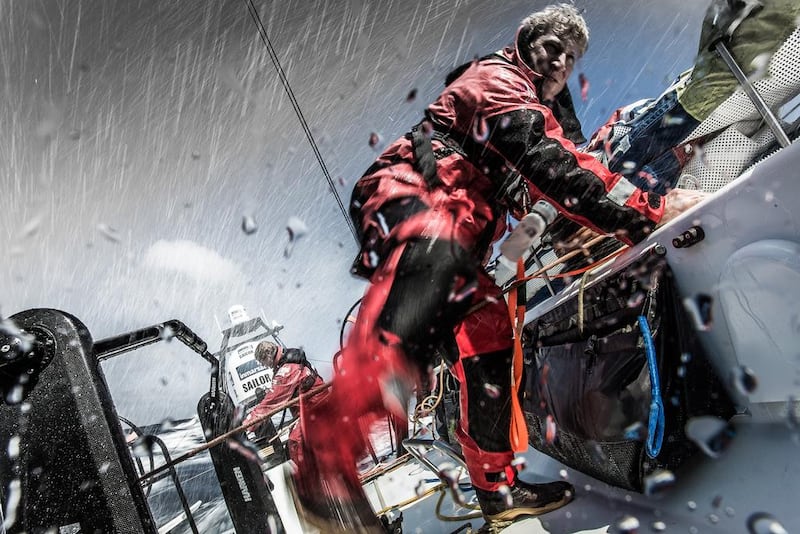In an idyllic setting at Alicante, Spain, overlooking the Mediterranean Sea, farewell parties will assemble along the undulating wooden dock.
Wives, husbands, parents and children will line up to bid adieu to the seven crews as an unspoken truth lingers like morning fog: in extreme sports such as endurance sailing, the finality of these moments is forever uncertain.
The 66 sailors in the Volvo Ocean Race can expect to experience all manner of danger over their 39,000-nautical-mile journey, from raging storms to rogue waves, but Saturday's send-off is about flowing salt water of a different type.
“Every time they leave, it is the same thing,” chief executive of the race Knut Frostad said.
“Those tears are very real.”
In proportional fashion, so are the safety concerns.
Five sailors have died in the Volvo race over its 40-year history, and numerous others have been plucked from the sea after falling overboard.
Injuries and illnesses, some life-threatening, are hardly uncommon. Neither is it rare for those realities to be largely set aside.
"It is in your mind," said Ian Walker, the skipper of the Abu Dhabi Ocean Racing boat, Azzam. "But if you actually stopped to think about these things, you would never go anywhere – and if your family knew what goes on out there, they'd never let you go anywhere, either."
Compared to some sports, sailing is grounded, safe and sane.
Adrenalin sports, such as skydiving and rock climbing, can cause catastrophic injuries in the blink of an eye. But there is one facet of sailing that separates it from others: isolation.
A lonely way station along the VOR route lies deep in the South Pacific Ocean. It is sometimes called Point Nemo and represents that place on the planet farthest from land, at 2,700 kilometres.
In the Volvo race three years ago, Azzam was 100nm from Point Nemo when the hull of the boat began falling apart.
No one was hurt, thanks to heroic repair work, but the incident underscored the dual notion of vulnerability and helplessness.
“At certain points along the way,” Azzam crewman Justin Slattery said, “the closest thing to you is a satellite.”
Slattery is one of three Azzam crewmen who have been designated as team medics, having completed weeks of training and certification courses.
Each boat must have two designated medics who are able to clear a clogged airway, apply plaster casts, suture torn skin, infuse intravenous fluids and execute an intravenous injection.
If the emergency exceeds the medics’ abilities, the boats have direct video lines to Derriford Hospital in Plymouth, England, where doctors can guide them through the nuances of surgery.
“We can talk them through some pretty advanced things,” Frostad said. “But if things are really bad, there’s nothing you can do.
“The worst is if there is something you possibly can do, but you may not be able to help, like with appendicitis.
“That is something that requires urgent treatment, and if you are 12 hours from the nearest helicopter – we can give them morphine and antibiotics to keep them stable, but only for so many days.”
The late Conny van Rietschoten, a two-time Volvo winner, had a heart attack during the 1981/82 race and was 10 days from the nearest port.
In one of the race’s defining, machismo moments, he refused to allow crewmen to contact a competing boat, Ceramco, which had a cardiologist aboard.
“If they had known I had a health problem, they would have pushed their boat even harder,” Van Rietschoten said later. “When you die at sea, you are buried over the side.
“Perhaps those Ceramco boys might have spotted me drifting by.”
His boat won the race and for better or worse – considering it relates to personal safety – his legend was cemented.
“That’s pretty hard core,” Walker said.
Van Rietschoten’s self-deprecating remarks underscore the gallows humour that pervades the sport. But there is nothing amusing about falling overboard. Dying alone at sea must rank high on the list of humanity’s nightmare scenarios.
“Or worse, being able to see the boat, but they can’t see you,” Frostad said.
Over the years, additional medical supplies have been airlifted by plane to a boat’s locale, then dumped into the water for retrieval by crewmen. In some cases, fate cannot be forestalled.
In the last Volvo fatality, Dutch sailor Hans Horrevoets was washed overboard in the Atlantic in mid-2006, seconds before he was scheduled to go below deck to change into his hazard gear.
Because it can take 10 minutes to get a high-speed yacht turned around, he was dead by the time he was located. Simon Fisher watched the resuscitation efforts fail.
“I think about it a lot,” said Fisher, now the Azzam navigator. “Something like that, it stays with you.”
But it did not dissuade him, nor many of his ilk. Occasionally, however, the risk for some becomes too oppressive.
Frostad, a genial Norwegian whose passion for the sport is unmistakable, skippered two crews in the Volvo race.
But he found himself so panicked about the safety of his crew, he left the boats behind and moved into an administrative position.
“It got to the point to where I wasn’t sleeping,” Frostad said.
Race officials have steadily ratcheted up the precautions over the years.
Each boat includes three watertight suitcases packed with medical gear, including 12 litres of intravenous fluids and the a fairly powerful painkiller, Tramadol.
Every sailor is required to pass a series of simulated disaster drills, where life-raft and man-overboard scenarios are replicated under extreme duress.
“Today, the boats are four times faster and, in that way, they are much riskier,” Frostad said. “But we have much more professional guys now, with training.”
Three of the five fatalities in the race occurred in the first year, 1973/74, when many in the race were amateurs and safety was mostly an afterthought.
Modern boats, worth €4.4 million (Dh20.5m), have man-overboard buttons that transmit a positioning signal to denote the exact spot where the sailor fell.
Just inside each boat’s main below-deck hatch, an array of personal safety devices are within arm’s reach for every crewman, including individual strobe lights and transponders. In rough seas, sailors wear life jackets and safety tethers.
Yet, uncertainty is always a puff of wind away.
VOR boats might be sailing at 40kph at night when there is a heightened risk of ploughing into a whale or a shipping container – or a discarded refrigerator, a tree, a dead cow or some wooden pallets.
The bows of the boats have a breakaway piece of carbon-fibre sheeting built into the hull specifically for that possibility.
“We’re pretty blase about what we do,” Walker said. “There is a lot of rubbish in the seas.
“Middle of the night, what we do is pretty insane – sailing along and you can’t see anything, and you’re doing 25 knots.
“You are absolutely sailing blind. But the odds are quite good, probably 10,000 to 1, that you will not hit something and sink.
“But nevertheless, there is a one in there somewhere. Yeah, it’s Russian Roulette.”
Just as surfers know sharks are in the water, sailors understand the risks involved and channel the fear accordingly.
If not ignore it altogether.
“In this sport, you cannot be affected by fear,” Frostad said. “If you are, this race is not for you.
“You should be taking a cruise ship around the world.”
selling@thenational.ae
Follow us on twitter at @SprtNationalUAE





